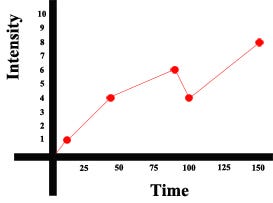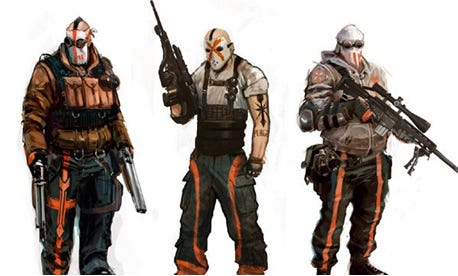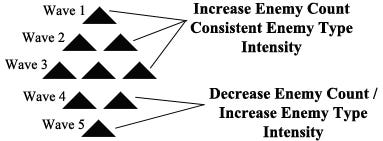
Featured Blog | This community-written post highlights the best of what the game industry has to offer. Read more like it on the Game Developer Blogs or learn how to Submit Your Own Blog Post
The Art and Science of Pacing and Sequencing Combat Encounters
Pacing and sequencing is an art, based on science. The following explores how artistic decisions based on scientific process pave the way to making awesome combat encounters.

Pacing and sequencing are neither art nor science, but a combination of both. If they were an exact science, making ninety quality combat encounters would be as easy as following a formula. It is not purely art either, for there is science to base our decisions upon. Rather, pacing and sequencing is an art, based on science. The following explores how artistic decisions based on scientific process pave the way to making awesome combat encounters.
The Combat Plan
In order to understand the science of pacing and sequencing, we must first understand a games combat plan. A combat plan is all the actions the player can choose during a combat encounter. In most games, that plan is a pyramid, made up of assess, attack and move choices.

Fig 1: Combat Plan Pyramid
At any point in a combat encounter, a player may assess the situation, attack their enemies and/or move. The more times the player stops what they are doing to pick a new action in the combat plan, the more intense the encounter becomes. For example, if there is a simple firefight going on with two enemies, the player may feel very comfortable within an attack action they are executing. However, if a reinforcement pod lands bringing new enemy types, the player must re-assess the change in the battle and pick a new combat action. Stopping their current action and choosing a different one makes the fight more intense. Increasing intensity in a combat encounter is a key concept to grasp for understanding pacing and sequencing.
Pacing
In general, pacing is the flow of the combat encounter. Respected God of War designer, Mike Birkhead put it best in his blog, Flark Design, Great fights have a flow to them. They start off strong, sure, but they also build; eventually building to a final crescendo. Lets break down a pattern that dominates most combat encounters in modern games to prove why building to a crescendo is so important for combat encounters. The pattern goes as follows: introduce the enemies, initiate the combat, escalate the combat, allow a midpoint for a breather and then end in a challenging climax. For an example, look at the below chart in which I have broken down a combat encounter into each stage of the pattern and the action that occurs at each stage.

Fig 2: Common Combat Pacing Pattern
Now that we have our basic example, we need to add empirical data to prove why the pattern provides good pacing. In order to achieve that data, we need a mathematical definition for pacing, intensity over time. Time indicates the duration of the action. Remember from above, that Intensity is how often the player must re-plan. Therefore, we represent intensity with a zero to ten number value representing re-planning, zero being no re-planning and ten being the most re-planning possible. Those numbers are added to the chart we made before and then plotted on a graph for easy visibility. 
Fig 3: Time and Intensity added

Fig 4: Pacing = Intensity / Time
The combat pattern is successful because it increases in intensity over time, provides a midpoint where intensity decreases and then a climax culminating in the most intense moment of the encounter. Great combat encounters use intensity to build to the crescendo that Birkhead mentioned. Not every combat encounter need follow the pattern we applied for the example, but it must hold true to increasing intensity. Increasing the intensity holds the tension of the fight, preventing the player from getting bored and keeps the combat fun.
Sequencing
I mentioned in the introduction that pacing and sequencing are both an art and a science. Pacing is the science and sequencing is the art. Refer to our example combat encounter chart again; the actions column determined the intensity. Those actions, like the arrival of new enemies or a helicopter flying in, are sequencing. These actions are created by combining different in-game factors. Those factors are: enemy types, enemy count, enemy spawn locations, time between spawns, music, dialogue and big events in the level, like destruction of the environment. These factors will expanded upon in detail further in.
In order to determine how successful a designer is at putting these factors together they must continually be play testing their encounters. The intensity and time numbers used to plot pacing graphs need to be driven from play tester results. According to Wikipedia, art is defined as, the expression or application of human creative skill and imagination. Combining the different factors together that constitute sequencing require great amounts of creative skill and imagination.
Enemy Type Factor
The enemy type sequencing factor is a character archetype the level designer spawns to fight the player, each one behaving differently from the next. A designer may spawn one type in a group together or combine different types.
Bringing in new enemy types is an easy way to change the intensity of an encounter because it introduces a new pattern for the player to deal with. For example, in an encounter full of machine gun guys, after so many machine gun guys die, the designer spawns a shotgun guy. The shotgun guy tries to get close to the player to shoot him instead of firing from far away. The intensity rises because the player deals with danger up close from the shotgun guy and danger from far away via the machine gun guy.

Fig 5: Different Enemy Types
Designers need to be careful with enemy types so that they do not introduce too many different types together at once. If too many types are on screen at once, it may overwhelm the player and make the fight too intense. Measure that by watching players during play testing.
Designers also need to keep in mind how AI work together, a shotgun and machine gun enemy are a better combination than a pistol and machine gun enemy. The difference in adjusting to a medium range and close attack pattern requires more re-planning and therefore higher intensity than the addition of another medium range attack enemy. Try to pick enemies whose strengths and weaknesses complement one another.
Enemy Count Factor
The enemy count sequencing factor is simply the number of enemies on screen at any point in the combat encounter. Adding or decreasing the number of enemies on screen determines the enemy count intensity. Enemy count is the easiest knob to turn to make an encounter more intense. Is one guy too easy, add another or vice versa.
The enemy count factor goes hand in hand with the enemy type factor. Eight enemies with low health and one attack will not be as tough as eight enemies with high health and three different types of attack. There are two main patterns when sequencing the enemy count for a combat encounter, the triangle pattern and diamond pattern. In the triangle pattern, the designer increases the enemy count while keeping the enemy type intensity consistent.

Fig 6: Triangle Enemy Count Pattern
In the diamond pattern, the designer starts the same as the triangle pattern but changes halfway to increase intensity by decreasing the enemy count while increasing the enemy type intensity.

Fig 7: Diamond Enemy Count Pattern
The triangle pattern is the most common pattern used in encounters. The designer simply adds more guys to each wave or as more enemies get killed. The diamond pattern is more common in boss or mini boss fights. The fight starts off with cannon fodder and as they get destroyed, fewer more difficult enemies enter the encounter and culminate in one incredibly challenging AI archetype.
Spawn Timing Factor
The spawn timing sequencing factor is how much time comes between each AI appearance on screen. If enemies come onscreen to quickly together, the player may not be able to recognize each pattern they must combat and the fight may become too intense. Conversely, if they slowly trickle out, the intensity may drop too quickly, boring the player. Spawning a combat encounter is like choreographing a violent dance. Let the player appreciate and digest the arrival of each new dancer to the stage allowing the player to plan the correct actions to take.
Be careful of the distance the AI spawns from the player because that effects timing as well. It is not just the time between spawns, but the time until engagement with the player. Spawning them too far away may make the AI feel like they are not a threat because it takes so long to reach you. Spawning them too close to the player allows the AI to reach the player before they have a chance to plan..
Enemy Spawn Location Factor
One of my personal favorite sequencing factors is the enemy spawn location factor, where enemies appear on screen. It is of upmost importance to keep the player's crosshairs moving around the screen in a fire fight and not focused too much in one spot. If the players keep shooting in one area to engage all the enemies, then the fight will not require much re-planning and not be very fun. Keeping the player moving around the scene not only helps intensity, but also helps them appreciate cool environments artists dress up.
Before we delve further, let's take a brief break and discuss how the human eye works when looking at the screen. Most people read from left to right and that causes the human eye to start in the left upper corner of the screen and move around in a circle through all four corners. Knowing this fun fact, always start your first AI spawn in the upper left and plot the subsequent spawns along the circle.

Fig 8: Eye moves from left to right in screen space
Following the circular pattern allows the player to easily digest what's happening on screen and plan accordingly. It also allows for the use of really interesting spawn animations which always make a combat encounter sing. With appropriate timing between the spawns the designer can reach deep into the modular spawn animation bag and combo repel, zip line, drop ship, closet, trap door and a myriad of other spawn animations together for a proper punch to the player's sensory system.
To test whether you are successful, watch your team mates or testers play your level. Specifically, watch their crosshairs. Are they not moving much and staying still in a specific part of the screen? If so, you need more intensity. If the cross hairs move around the screen too much, making the player feel frustrated, you need to slow down the spawning through the circle so the player digests each new enemy. Find a sweet spot where the player is moving their crosshairs around different parts of the screen, watching the AI enter but not feeling overwhelmed.
Level Event Factors
Level event sequencing factors are scripted events designers add to the level that help tell the story of the fight. Level events can be anything from cover destroying, paths getting blocked to whole rooms catching on fire or flooding. They add intensity because they force the player to re-plan.
Consider the fight in Uncharted 3 on the cruise ship where the room steadily becomes more and more flooded. As the room fills with water, the playable game space shrinks and the player must re-plan with each new flood state change in the room. Because of the intensity provided by the flooding room, the designer of the level did not have to add as many enemies as other fights to capture an intense feeling.

Fig 9: Uncharted 3's Cruise Ship Level Flooded during Combat
Dialogue Factor
The dialogue sequencing factor is the use of dialogue to foretell a change in the combat spawning or to broadcast that a level event is about to occur. For example, if enemies fall back and say, "Let's get outta before the big monster arrives," then the player will immediately stop what they are doing and re-plan to figure out how they are going to fight this new big monster. Without the dialogue, the intensity would change because the player would have less time to re-plan his next move. AI broadcasting pertinent information about a combat space via dialogue lines is a great, cheap way to affect combat intensity.
Music Factor
In general, music adds scale and dramatizes events. In a combat encounter, combat music helps dramatize the combat and becomes another layer of the combat pattern the brain begins to recognize and learn. For a funny experiment, have someone play a white box combat setup with and without music and ask them which felt more intense. The one with music will always feel more intense because of the drama the music adds, it takes the player to another emotional level.
Conclusion
Combining all the factors together is the art of sequencing. The timing at which sequencing factors occur is the science of pacing. While executing pacing and sequencing in combat encounters, it is important to remember that they are two separate but linked aspects of an encounter, a change to one invariably affects the other.
Read more about:
Featured BlogsAbout the Author(s)
You May Also Like







.jpeg?width=700&auto=webp&quality=80&disable=upscale)








